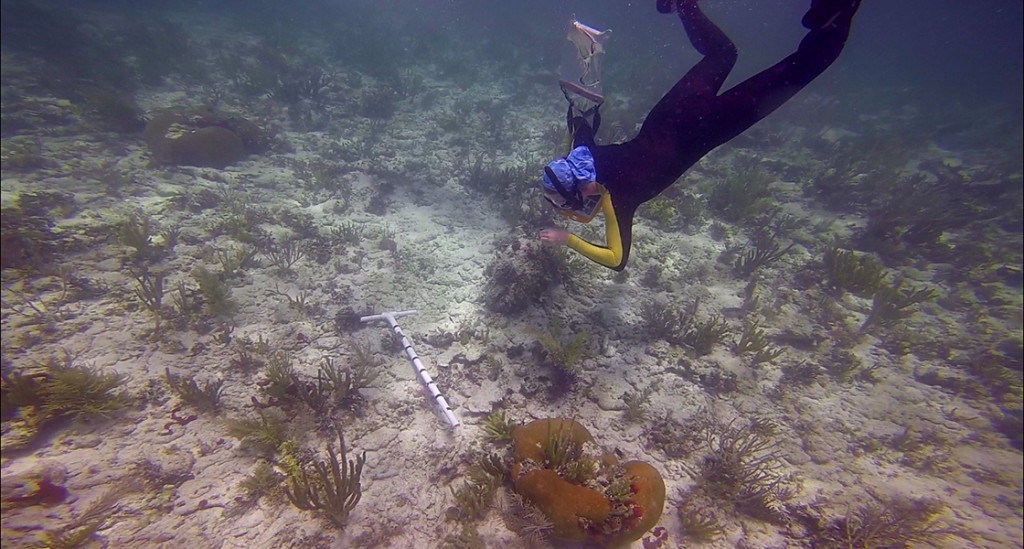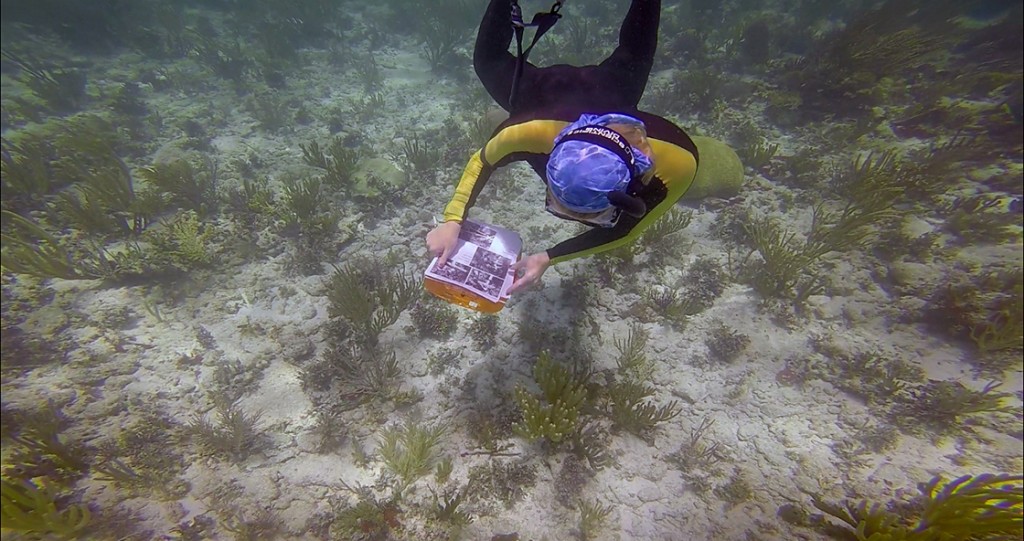After a week of decompression training and diving, it was time to ditch my bailout bottle and strap on a regular SCUBA unit. As part of deal with the University of Miami, a few lucky graduate students get to spearhead their own research projects while working as biotechs at BISC. During my second week at the Park I got to participate on a few of the projects they’re working on.

UM graduate student Dana bagging a lionfish. Dana’s project involves lionfish outreach and education; this fish will be used to help spread more information.
Remember from my last post how I mentioned that the Park had requested deco training so they could extend the reach of their lionfish-culling project? Well, you might ask, why are they hunting lionfish in the first place? Don’t these beautiful fish have just as much right to the reefs as we do? The answer is no. Lionfish are native to the western parts of the Indo-Pacific, not the Atlantic and Caribbean. They inhabit coral reefs, preying upon just about anything that they can fit into their mouths. Lionfish are quite popular in the commercial aquarium trade, and unfortunately they were accidently introduced to Biscayne Bay about 20 years ago. Since then they have spread like wildfire across the Caribbean, Atlantic and even into the Gulf of Mexico.

Shelby Moneysmith, BISC’s PDO and the region’s RDO is still a biotech at heart. I haven’t gotten a picture of a live lionfish yet because Shelby and the rest of the biotechs are too good at finding them before I do!
Lionfish are such potent invaders because they have no natural predators on the East Coast. Also, they tend to specialize in eating young fish, which further complicates the issue. BISC has gone through considerable lengths to try and cull lionfish as much as possible. Not only does the Park dispatch the intruders, they also study their diet and behavior. Lionfish are shot at depth using a poll spear, and then brought to the surface. Back at HQ the lionfish are measured, tagged and frozen. Every so often the Park distributes the lionfish to local schools for outreach and science education. Of course, every once and awhile a hungry biotech can fillet a fish or two.

After being brought back to HQ, lionfish are measured and tagged. The data collected by the Park goes back to just after the start of the invasion.
I’ve worked on projects in the past where culling is a major part of the investigation. While I cannot support aimless killing, it’s remarkable to see how negative of an effect these lionfish can have on a reef. I was really glad to have been able to participate on this project, both on deco and at shallower depths. Also, I couldn’t help but try my hand a cooking up some lionfish fillets for myself!

Not all of the lionfish made it into the freezer. As part of outreach, some folks are trying to get lionfish on the menu at local restaurants. I recommend the fish tacos!
After diving with the Park for over a week it was time to switch gears and try my hand on some other projects. I was able to join two other graduate students for a couple of days working a turtle nesting project and a coral recovery project. Both studies involve making observations in the field, and analyzing the data back in the lab. Because neither involves SCUBA, things were (superficially) less complicated. Or so I thought!
Typically beaches along the edges of the outlying keys are sampled for potential turtle nests multiple times a week. Loggerheads, greens and hawksbills are just a few of the turtles that might utilize the relatively projected sandy shores of the Park to lay their eggs. However, these turtles lay their eggs by night, which definitely complicates the issue. To monitor the beaches for new nests, we drove a Park boat from key to key, wading out in shallow water to walk along the hot, sandy, bug infested shores looking for signs of activity. If a new nest is found, the interns (who get incredibly excited when a nest is found) carefully dig in the sand. Once the eggs are located they are reburied and a protective mesh screen is placed on top. After about 2 months the screen is removed so that the hatchlings can head for the cover of the ocean. It was hard work! But definitely rewarding.

UM graduate student Kelsey Armstrong suites up to survey a beach for potential sea turtle nests. The sun is hot but the bugs still bite!

UM graduate student Tina Van Doornik prepares to wade to shore. We walked along the sandy beaches of the keys looking for sea turtle activity. It was kind of nerve-wracking wading through the warm shallow water, but Tina’s enthusiasm for sea turtles was infectious.
After scouring the beaches for nests all morning we headed to a shallow reef to anchor the boat and do coral health surveys. About 6 months ago a handful of young individual corals were sampled. Sizes were measured and pictures were taken. You can get a general idea about a coral’s well being based on tissue color. Corals have a symbiotic algae living in their tissue, and these algae make sugar from the sun, and in turn nourish the coral. They also give the coral their vibrant colors. If a coral becomes stressed it will release the algae. A “bleached” coral is not happy, and although they may recover, typically this leads to the death of the reef.
- As part of her project, Kelsey is comparing coral health over a span of several months.
- Looking for her individuals was kind of like looking for a needle in a haystack. But finding a positive ID was rather exciting. Kelsey compares pictures taken a few months ago to try and find her corals.
Our task for this project was to try and local the small individuals based on pictures taken months ago. Once we found our target, we assessed their health (bleached, recovered, or dead) and took pictures for comparison. This was all easier said than done. The shallow reef was exposed to wind and swell, and since we were doing these surveys using snorkels we got moved around quite a bit.
These three projects are prime examples the natural resource work conducted by the Park Service. In collaboration with local institutions, our natural and cultural resources are well studied and managed. It was really excited to participate on so many projects, especially since working in tropical ecosystems is still relatively new to me. I’d like to thank the UM graduate students Dana Tricarico, Nicole Besemer, Kelsey Armstrong, and Tina Van Doornik for letting me tag along. Now I’m off to the Virgin Islands National Park to continue my dive training.





It is informative to know that the lionfish is not a native and that it is a vicious and destructive predator.
Its also good to know that you are helping to protect other fish.
Fish that we consider palatable are the ones that have fins and scales.
Aba